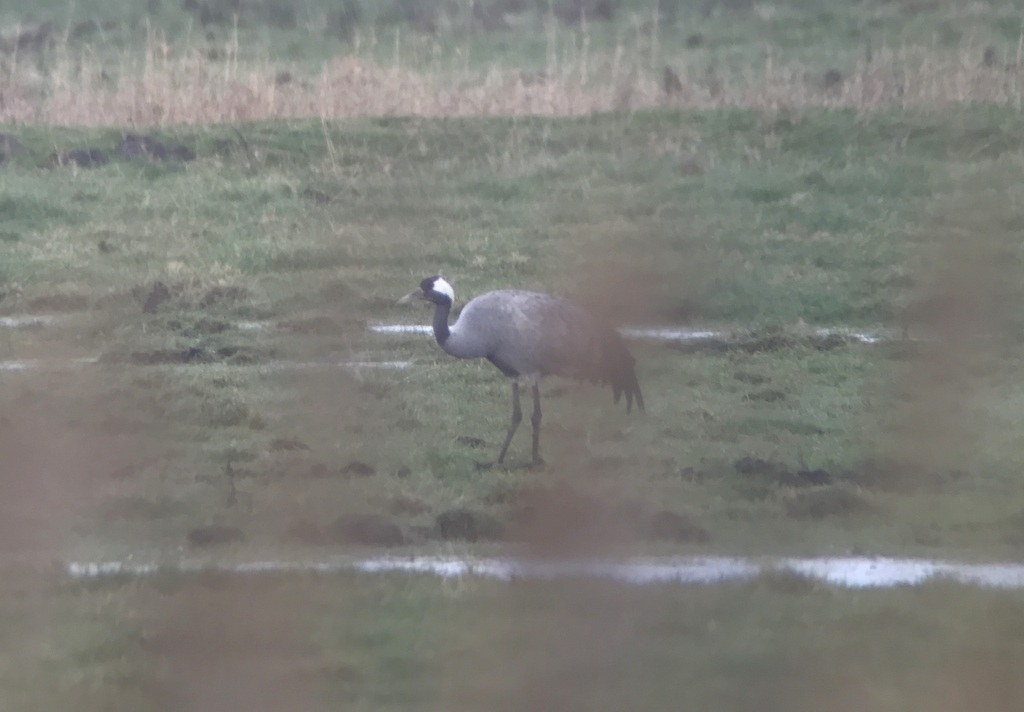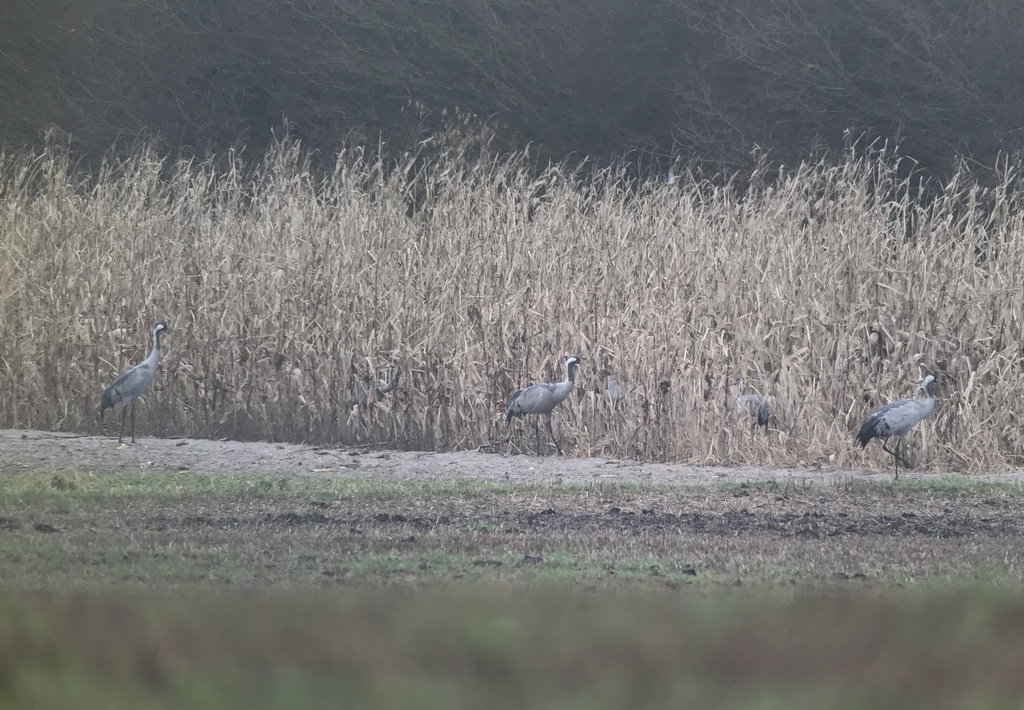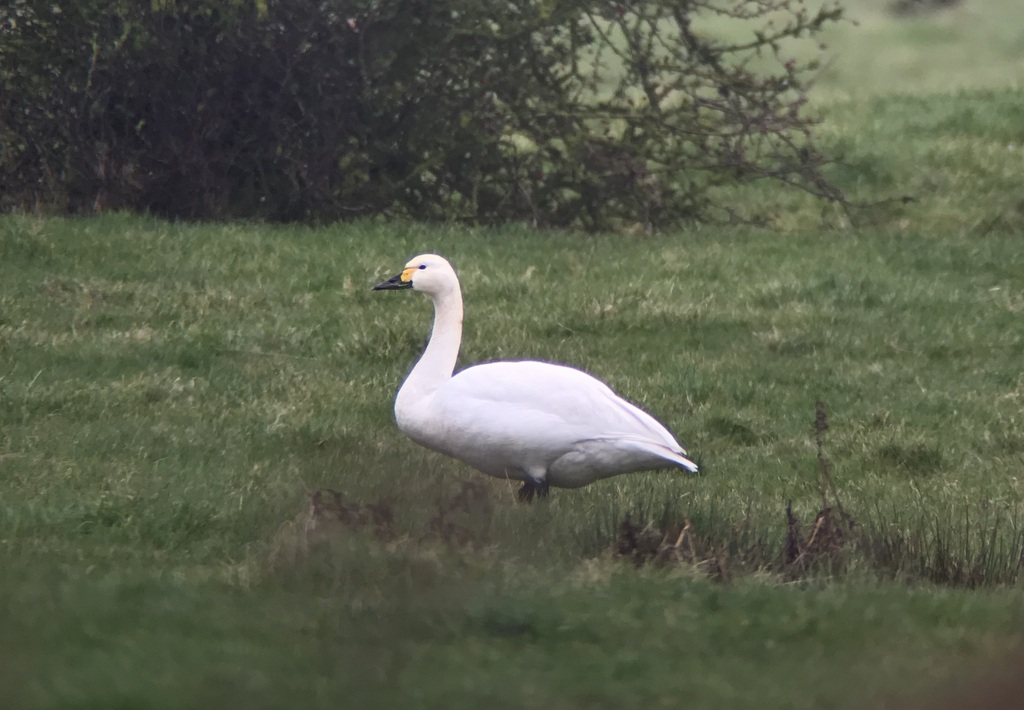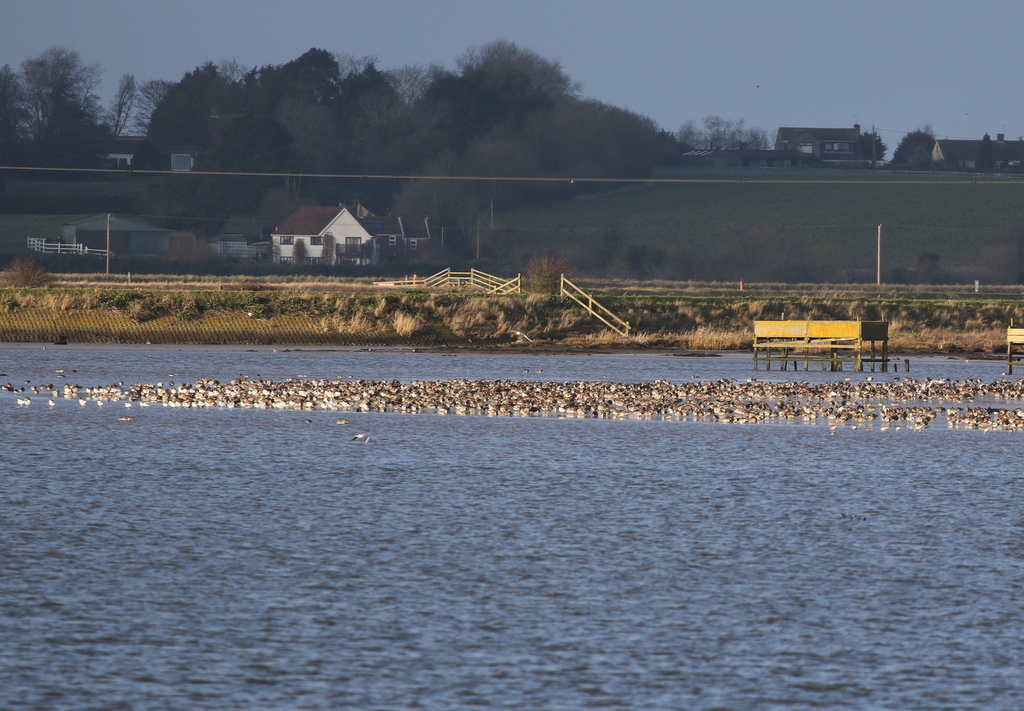A Private Tour down in the Norfolk Broads today. After snow overnight, the wintry showers were supposed to die out through the morning and it was meant to brighten up. It never really happened that way, remaining mostly cloudy all day. but at least we were able to largely dodge the showers until late in the day. And it didn’t stop us seeing some good birds.
After meeting in Hickling, we headed round towards the coast. A slow drive stopping to scan some of the fields which the Cranes favour failed to yield the hoped for reward, but it was still cold and cloudy so they were probably hiding somewhere sheltered. We stopped in a convenient layby and got out to scan the fields.
There were a couple of large herds of Mute Swans here, on either side of the road, but nothing else with them. Further over, we could see a hundred or so Pink-footed Geese at the back of the grazing marshes, which were covered in Lapwing and Golden Plover. A Green Sandpiper called over towards the reeds, but we couldn’t see it. A Common Snipe flew up from the grass. We had a good look through the scope at one of the Fieldfares feeding among the molehills.
There were a few raptors too, starting to wake up. Three Marsh Harriers circled up out of the reeds and a Common Buzzard perched on the bank, trying to warm itself. A couple of Kestrels were perched on the wires.
Continuing on our way, we headed inland in search of more swans. As we parked at our next stop and got out of the car, we could see a little group of no more than half a dozen out on the grazing marshes. A quick look through the scope confirmed they were a mixture of Mute Swans together with a couple of Whooper Swans. There were a few more down out of view in a ditch, so we decided to walk round on the river bank to try to get a better look.
From up on the bank, we scanned the grazing marshes the other side of the river and immediately spotted a Common Crane out on the grass. A second Crane was nearby, but they were half hidden behind the reeds. We had to find a gap we could see over, but we eventually got a good look at one of the Cranes through the scope.

We could hear Bearded Tits calling from the reeds, but couldn’t see them. It was cold and there was a fresh breeze, so they were keeping well tucked down this morning. A Reed Bunting called and showed itself briefly. A Cetti’s Warbler was more typically elusive. However, we had great views of a Grey Wagtail which flew in and landed in a nearby farmyard, picking around the edge of a muddy puddle.
There was a better view across to the swans from up here and now we could see there were actually five Whooper Swans here. Through the scope, we could see the wedge-shaped yellow patch on their bills.

We could see a number of Chinese Water Deer out on the grass too, which once again was liberally sprinkled with Lapwings and Golden Plover. Suddenly all the birds erupted, taking to the air and whirling round. There are often Marsh Harriers here, but we couldn’t see any likely culprits until one of the group spotted a couple of raptors circling high over the marshes.
It was immediately clear there was a small bird of prey and a much larger one. The smaller bird was a Sparrowhawk, which was mobbing the bigger one, but it was only as the latter turned that we could see it was not one of the usual harriers or buzzards. It was another hawk, but a really huge one, a Goshawk.

Once all the group were on it, we had a closer look at the Goshawk. As it circled, we could see it was a young bird, born last year, rather brownish. As well as the huge size, we could see the distinctive long wings with bulging secondaries, broad-based and rounded tail and protruding head.
The Sparrohawk lost interest and flew off, while the Goshawk continued to circle and drift further away. At one point, it straightened up and flew a short distance, with deep, heavy wingbeats, very different from the fast bursts of flapping of the Sparrowhawk. While we do have Goshawks in Norfolk, they are very rare in the Broads, so this was a complete surprise.Young birds are very prone to wandering though and it was apparently a good breeding season for them in 2017. A real bonus for the day!
It was cold up on the river bank, so once the Goshawk had drifted away, we headed back to the car and a chance to warm up as we drove to our next stop. The stockman was just going in to feed the cattle in the barn next to where we had parked and as he did so he flushed out a Barn Owl, which flew across in front of us, over the bank, and disappeared down on the other side of the river.
We pulled up next on the edge of some overgrown fields, sown with a seed cover crop. Here we spotted a small group of finches fly up into an oak in the hedge and quickly got the scope on one, a smart male Brambling. Unfortunately, the birds flew again before everyone got onto it.
We spent a few minutes trying to get a better look at the finches. We walked up the footpath on the edge of the field and back again, but a lot of the birds were either in the trees above our heads or had flown off over the back of the field. We could hear the nasal call of more Bramblings and the hard calls of Linnets flying over, as well as plenty of Chaffinches and a few Goldfinches. Finally, they all flew across and landed in a tree on the edge of the field, where we could all get a good look at them.
Back in the car, we had another opportunity to warm up as we drove south. A quick glance out of the window though and we spotted some dark shapes in a field in the distance. We turned round and found a convenient place to stop. Once out of the car, we could see they were Cranes, and plenty of them!

The Cranes were hard to count. A few were standing around on the edge of the field, but more were feeding in the vegetation in a tall cover strip. Through the scope, we could see some of them ripping at the tall stems, but there were several more deep in the crop – we could just see bits of grey shapes moving around inside.
As we scanned across, we could see several more Cranes around the edge of the next field. An attempt to count them all got to 26 in total, but it is very possible there were more than that, given we struggled to see how many were deep in the cover strip. This is a very impressive flock by UK standards, a significant proportion of the Broadland total in one group, great to see.

Unfortunately, it had started to spit with wintry rain now, so we didn’t linger as long as we might have done with the Cranes, but got back in the car and moved on.
Having not found any Bewick’s Swans earlier, we headed round to Halvergate next to see if we could find any here, another regular site for them. At first, we saw several groups of Mute Swans before we spotted four smaller birds on their own on the grazing marsh. Stopping in a convenient gateway, we got out to confirm they were four Bewick’s Swans.

Through the scope, we could see the smaller, squared off yellow patch on the bill of the Bewick’s Swans, very different from the more extensive, wedge shaped yellow on the Whooper Swans we had seen earlier. The Bewick’s Swans were also noticeably smaller and shorter-necked.
There was now a request to find somewhere warm to have lunch or a hot drink, so after an abortive attempt to visit the pub in Halvergate, which was closed, we headed back to Acle. The hot chocolate was especially welcome today!
After a break, we resumed our quest for more birds. There has been a Glossy Ibis on the outskirts of Great Yarmouth for the last week so, as it was just about on our way, we headed over to see if we could see it. There was no sign if it in its favourite wet field, just a few Moorhens. A Kingfisher zipped low across the grass and disappeared into a ditch, unfortunately too quickly for most of the group to get onto it.
Another birder was just leaving, and helpfully pointed us a little further along the road as he passed. There was the Glossy Ibis out on the back of the grass, with a few more Moorhens for company. It promptly went to sleep, but thankfully only for a couple of minutes before waking up, preening and resuming feeding in a flooded patch in the grass. Through the scope, we could see its long, downcurved bill.

Glossy Ibises are still quite rare but increasingly regular visitors to the UK, with ringed birds seen here in recent years known to have originated from the expanding Spanish population.
Having enjoyed nice views of the Glossy Ibis, we set off on our way again. Our next destination was Waveney Forest. As we walked in through the trees, there were several Great Tits and a single Coal Tit coming to the feeders at the cottage. A Siskin flew over calling. Deeper in the trees, a Green Woodpecker called and flew across the path in front of us, up into the trees.
We made our way over to ‘the mound’ which overlooks Haddiscoe Island. The regular returning Rough-legged Buzzard has been here for a while now, and this is generally the best place to see it from. Scanning the posts and gates out on the Island, we could see several Common Buzzards and Kestrels. What looked like the Rough-legged Buzzard was unfortunately right over the far side of the island with its back to us, and even through the scope it was hard to make out much detail. We could see a pale off white crown and pale whitish spots in the mantle and scapulars. We waited a while to see if it would turn round, or even better fly, but it didn’t.
While we waited we did spot a group of about 15 Bearded Tits swinging in the tops of the reeds, feeding on the seedheads. The sun had come out and they had found a sheltered spot which was catching some warmth in the afternoon light. We had a great look at them through the scope, and could see the grey heads and black moustaches on the males.
It was time to move on again, before we got too cold. On our way back north, we stopped on the south shore of Breydon Water. It was about an hour and a half after high tide and the water was now starting to go out. There were thousands of birds gathered on the mud on the far side – ducks, waders and gulls.

Through the scope, we could see the birds were neatly sorted into groups. Over to the right were mostly Lapwing and Golden Plover. In the middle, shining bright white in the afternoon sun, were loads of gulls, mainly Black-headed and Common Gulls. To the left, was more of a mixture, thousands of Wigeon with waders scattered through them including Black-tailed Godwits, Dunlin and on the end a number of Avocets. A Great Crested Grebe swam past.
It was already getting late by the time we left Breydon Water. Given the weather, we were not planning to spend too long at Stubb Mill this evening, but we thought we would try to call in for the last half hour. Unfortunately, as we drove back north we could see dark clouds gathering and by the time we got back to Hickling, it was starting to rain. We sat in the car for a couple of minutes trying to work out whether it would clear, before deciding to call it a day.
It was a wise call, as the rain turned to sleet on the short drive back to where we had started. But despite the weather at the end, we had enjoyed a very successful if rather chilly day today. Well worth going out for!
















